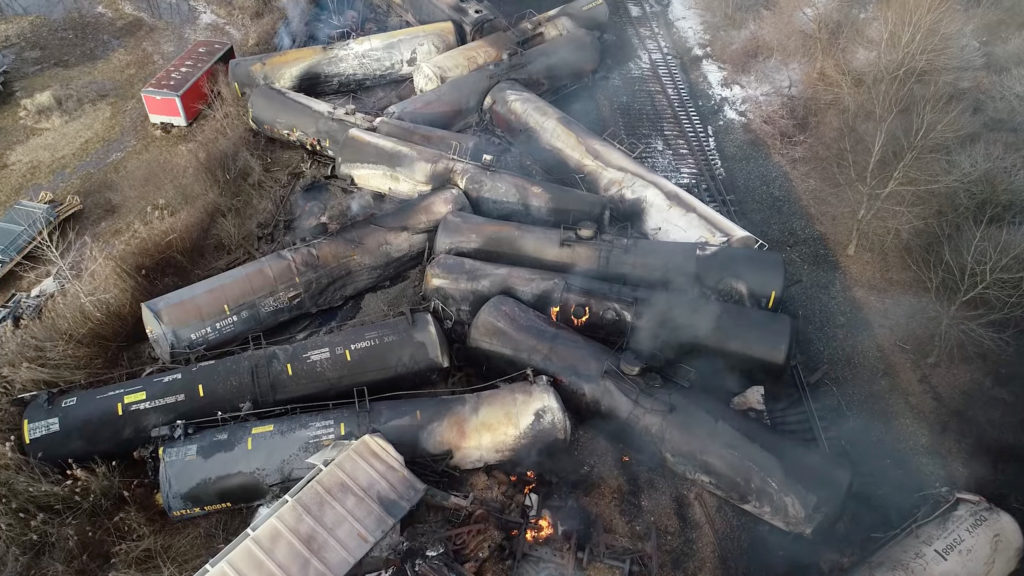Toxic Chemicals From Ohio Train Derailment: Prolonged Presence In Buildings

Table of Contents
Types of Toxic Chemicals and Their Persistence
The derailment released a cocktail of toxic chemicals, including vinyl chloride, butyl acrylate, and ethylene glycol monobutyl ether, among others. Understanding the properties and persistence of these chemicals is crucial to assessing the long-term risk. These substances have varying degrees of volatility and solubility, impacting how they interact with building materials and the environment.
- Vinyl chloride: Known for its carcinogenic properties, vinyl chloride is a volatile organic compound (VOC) that can easily become airborne. Its half-life in the environment can vary depending on factors like temperature and soil composition, but its persistence warrants concern.
- Butyl acrylate: Another VOC, butyl acrylate, is also a significant concern. It can irritate the eyes, skin, and respiratory system, and its persistence in building materials, especially porous ones, requires careful evaluation.
- Ethylene glycol monobutyl ether: This chemical is less volatile than vinyl chloride and butyl acrylate, but it's still capable of lingering in the environment and potentially contaminating buildings through various pathways.
The concept of half-life is crucial. A chemical's half-life refers to the time it takes for half of the substance to break down. Chemicals with longer half-lives pose a greater long-term risk of building contamination. Furthermore, bioaccumulation—the process where chemicals build up in living organisms or building materials over time—can significantly amplify the risk. Dust within buildings can act as a reservoir for these chemicals.
| Chemical | Key Properties (Relevance to Building Contamination) | Potential Health Effects |
|---|---|---|
| Vinyl Chloride | Volatile, carcinogenic, potential for airborne and surface contamination | Liver cancer, other cancers, respiratory problems |
| Butyl Acrylate | Irritant, potential for absorption into porous materials | Eye, skin, and respiratory irritation |
| Ethylene Glycol Monobutyl Ether | Less volatile than vinyl chloride, potential for groundwater contamination | Kidney and liver damage, central nervous system depression |
Pathways of Contamination in Buildings
The toxic chemicals released from the Ohio train derailment can contaminate buildings through various pathways:
- Airborne Contamination: Volatile chemicals like vinyl chloride and butyl acrylate can easily become airborne and penetrate building envelopes, settling on surfaces, and potentially being inhaled by occupants.
- Surface Contamination: Chemicals can settle directly onto building surfaces, including floors, walls, and furniture. Porous materials, such as carpets, drywall, and insulation, are particularly susceptible to absorption.
- Water Contamination: Contaminated soil and groundwater can leach into building foundations, potentially contaminating water sources within the building. This is especially concerning for older buildings with less robust foundation sealing.
- Soil Contamination: Contaminated soil surrounding the building can act as a reservoir for chemicals, leading to long-term indoor air and water contamination via vapor intrusion and groundwater migration.
- Ventilation Systems: Building ventilation systems can inadvertently spread contamination throughout the building if contaminated air is drawn into the system. Conversely, well-designed ventilation systems can aid in mitigation by removing contaminated air.
Health Risks Associated with Prolonged Exposure
Prolonged exposure to the chemicals released during the Ohio train derailment poses significant health risks, both short-term and long-term.
- Respiratory Problems: Many of these chemicals can irritate the lungs and cause respiratory problems, ranging from coughing and shortness of breath to more serious conditions like asthma and bronchitis.
- Cancer Risk: Vinyl chloride, in particular, is a known carcinogen, increasing the risk of liver cancer and other cancers. Long-term exposure to other chemicals may also elevate cancer risk.
- Neurological Damage: Some chemicals can affect the nervous system, leading to neurological damage and cognitive impairments.
- Reproductive Health: Exposure to certain chemicals may negatively impact reproductive health in both men and women.
- Immune System Dysfunction: Several of the released chemicals can impair the immune system, making individuals more susceptible to infections and illnesses. Children and the elderly are particularly vulnerable due to their developing or compromised immune systems.
It's crucial to note that the long-term health effects of exposure to these chemicals are still being researched, but preliminary findings indicate significant cause for concern.
Mitigation and Remediation Strategies
Addressing the long-term contamination risk requires a multi-pronged approach:
- Air Quality Testing: Professional air quality testing is essential to determine the extent and nature of contamination within buildings. This should include testing for specific chemicals released during the derailment.
- Soil Remediation: Contaminated soil around buildings may need to be removed and replaced. Remediation techniques will vary depending on the level and type of contamination.
- Building Decontamination: Professional cleaning and decontamination may be necessary to remove chemicals from building surfaces. This can involve specialized cleaning techniques and equipment.
- Ventilation Improvements: Improving building ventilation, potentially with the addition of high-efficiency particulate air (HEPA) filters, can help remove contaminated air and reduce indoor exposure.
- Personal Protective Equipment (PPE): Anyone involved in cleanup or remediation efforts should wear appropriate PPE, including respirators, gloves, and protective clothing.
Ignoring the potential for long-term building contamination from the Ohio train derailment's toxic chemicals is not an option. Prompt action is vital.
Conclusion
The Ohio train derailment has highlighted the significant and prolonged risks associated with toxic chemical exposure in buildings. The persistence of these chemicals necessitates thorough investigation, comprehensive testing, and appropriate remediation strategies to protect public health and safety. Ignoring the potential for long-term contamination could have devastating consequences for affected communities. Don't risk your health. If you live near the site of the Ohio train derailment or suspect your building may be contaminated with toxic chemicals from the incident, contact a qualified professional for testing and remediation immediately. Learn more about the long-term impact of the Ohio train derailment's toxic chemicals and ensure your building’s safety. Proactive steps are crucial in mitigating the long-term effects of this environmental disaster and protecting the health and well-being of those affected.

Featured Posts
-
 Razer Blade 16 2025 Review Is The High Cost Justified By Ultra Performance
Apr 22, 2025
Razer Blade 16 2025 Review Is The High Cost Justified By Ultra Performance
Apr 22, 2025 -
 Chinas Impact On Luxury Car Sales Bmw Porsche And Beyond
Apr 22, 2025
Chinas Impact On Luxury Car Sales Bmw Porsche And Beyond
Apr 22, 2025 -
 Razer Blade 16 2025 Ultra Thin Laptop Performance And Price Analysis
Apr 22, 2025
Razer Blade 16 2025 Ultra Thin Laptop Performance And Price Analysis
Apr 22, 2025 -
 Obamacare Supreme Court Case Trumps Role And Rfk Jr S Potential Gain
Apr 22, 2025
Obamacare Supreme Court Case Trumps Role And Rfk Jr S Potential Gain
Apr 22, 2025 -
 Lab Owner Pleads Guilty To Falsifying Covid Test Results
Apr 22, 2025
Lab Owner Pleads Guilty To Falsifying Covid Test Results
Apr 22, 2025
Latest Posts
-
 Stallones Missed Opportunity Reflecting On Rejecting Coming Homes Oscar Win
May 12, 2025
Stallones Missed Opportunity Reflecting On Rejecting Coming Homes Oscar Win
May 12, 2025 -
 Free Streaming Watch Sylvester Stallone In Action Thriller Armor This Month
May 12, 2025
Free Streaming Watch Sylvester Stallone In Action Thriller Armor This Month
May 12, 2025 -
 Sylvester Stallones Regret Turning Down The 1978 Best Picture Coming Home
May 12, 2025
Sylvester Stallones Regret Turning Down The 1978 Best Picture Coming Home
May 12, 2025 -
 Sylvester Stallone Action Thriller Armor Now Streaming Free This Month
May 12, 2025
Sylvester Stallone Action Thriller Armor Now Streaming Free This Month
May 12, 2025 -
 Kojak On Itv 4 Everything You Need To Know
May 12, 2025
Kojak On Itv 4 Everything You Need To Know
May 12, 2025
